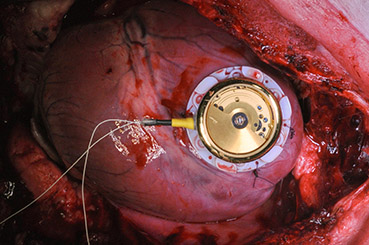
Researchers in Switzerland are developing a pacemaker which has no leads and no battery. With this in mind, the prototype is aimed to solve two of the major problems with traditional pacemakers. The idea of the device was inspired from the mechanism used in automatic wristwatches. Similarly as to how an automatic wristwatch harvests its energy from the wrist by transforming mechanical energy into electrical energy, the battery- and lead-less pacemaker is powered by heart motion. Adrian Zurbuchen, developer of the device (PhD candidate in the Cardiovascular Engineering Group of the ARTORG Center, University of Bern, Switzerland) spoke at the European Society of Cardiology congress (ESC; 30 August–3 September, Barcelona, Spain) on this project. He gives insights on the development of the device to Cardiac Rhythm News.
What is the rationale to create a batteryless cardiac pacemaker?
Today’s pacemakers have two weak spots. Firstly, pacemaker leads are prone to fracture and can pose an imminent threat to the patient. Secondly, the lifetime of a pacemaker battery is limited. Therefore, patients have to undergo repeated surgical interventions to replace the pacemaker prior to a complete battery depletion. Furthermore, batteries require a lot of space and are heavy. As a consequence, pacemakers are implanted at the remote subclavicular position and therefore require pacemaker leads transmitting the electric stimuli to the heart. A battery- and lead-less pacemaker is therefore highly desirable.
Please explain how the device works?
Our harvesting device is based on a clockwork of an automatic wristwatch. This technique is well-known for harvesting the energy of a person’s wrist motion. In contrast to a wrist motion, the heart beat is a very continuous cyclic motion. As we have learned from magnetic resonance imaging (MRI) studies, the enduring myocardial muscle shows high accelerations up to 5g. By sewing our energy harvesting device on the myocardium, the system is exposed to these externally applied accelerations and the internal eccentric mass starts to oscillate. This rotation motion spans a mechanical spring. When the spring is fully charged it starts unwinding and thereby propels an electric micro-generator. This results in an intermittent alternating current which can now be used to power a pacemaker.
The research on the modelling of this energy harvesting mechanism was published in Ann Biomed Eng 2013 Jan;41(1):131-41.
What are the components of this device?
Our energy harvesting prototype consists of a housing which features eyelets for suturing the device onto the heart. In the housing is a rig holding the main four components: an oscillation weight, a mechanical rectifier, a mechanical spring and an electric micro-generator.
In addition, we developed a pacemaker electronic which was used to pace the heart with the energy provided by the harvesting device. This circuit was part of the experimental setup but not an integral part of the harvesting device.
How long has this device been under development? Who pioneered this idea?
The idea came from Professor Rolf Vogel, my PhD supervisor. He is senior cardiologist and engineer—a combination which allows him a very practical thinking. As a Swiss, the idea of using a watch mechanism was then quite obvious to him. I myself started investigating this topic in my master’s thesis project (Master of Biomedical Science) four years ago. After that, I continued my research as a PhD student in the Cardiovascular Engineering Group of the ARTORG Center (University of Bern).
What data are available to support its feasibility?
This study is based on several steps of engineering. First, there exists a mathematical model which can predict the energy outcome for any given externally applied motion. Therefore, we can test the device in-silico with different heart motions. Second, we developed a hexapod robot (a.k.a. steward platform) which is able to mimic heart motions. This allowed us to test a prototype in an in-vitro setup in a very fast and uncomplicated manner. Third, the device has been tested in in-vivo experiments with sheep and more lately with a domestic pig to show the feasibility of harvesting energy and also to use this energy to pace the heart.
The in-vivo experiment with a 60kg domestic pig was presented in an abstract at the ESC Congress 2014. The results of the experiment showed that this novel energy harvesting device supplied the pacemaker with enough energy to perform continuous VVI pacing (pacing threshold 1.0 V/0.5ms, sensing 9.8mV, impedance 1279Ω) at 130bmp (pacing output 1.6 V/0.8ms). Simultaneously, the harvesting device generated a mean output power of 52μW over an additional load resistor of 1kΩ.
With this experiment, we demonstrated the feasibility of pacing the heart using its own mechanical activity. The harvested energy exceeded the power requirement of a modern pacemaker (∼10μW).
What are the potential advantages of this device compared to existent pacemakers?
The primary goal would be to make pacemakers battery- and lead-less. This would eliminate the earlier mentioned two weak spots of a pacemaker and is therefore highly desired. In addition, the pacemaker is only one of many applications energy harvesting devices could be used for. Defibrillators, loop-recorders, neurostimulators, drug delivery pumps and bone growth stimulators are only a few other examples. To replace the battery with an alternative continuous power source makes devices autonomous and ultimately patients to be independent. What more can you wish for as patient than to be healthy and independent?
What are the next steps of development?
There are several things we need to investigate in depth: For example should we improve size and weight of the device. Furthermore, the eccentric mass needs to be redesigned to make it more sensitive to heart motions. In general, developments go into the direction of having intraventricular harvesting devices which can be delivered in a minimal-invasive transvascular implantation approach. This would bring a big advantage especially for intraventricular pacemaker devices.
How far are we to star human testing?
This depends on the industrial partner who is doing the implementation. However, so far we have no such partner and therefore any time estimation would be inappropriate.









